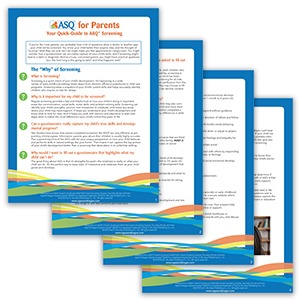How To Introduce the Questionnaires in Ways that Ease Parents’ Concerns
Help parents get comfortable with screening

Has your program ever had difficulty getting parents to participate in ASQ®-3 or ASQ®:SE-2 screenings? Reluctance is often due to a lack of understanding about why screening is necessary, what to expect, or how answers will be used.
You can provide reassurance and allay fears by communicating thoughtfully about the screening process from the get-go. Here are some tips for introducing ASQ® questionnaires—and increasing the odds that parents can complete them with confidence.
Make a Good First Impression
Tools you can use |
|
Download our quick reference guides: |
Focus on making the initial introduction to ASQ as friendly and personal as possible. Ideally this discussion would take place in the family’s home or in a meeting with the parent. But if your program staff does not have enough resources for face-to-face visits, they should at least try to schedule a phone conversation.
Regardless of where and how the questionnaire will be completed, be sure to explain the importance of screening and the goals of the particular questionnaire. These handouts can help: What is ASQ-3? and What is ASQ:SE-2?
Remember: A positive tone and sensitivity are key to establishing open communication and ultimately encouraging participation.
Need help? If you can’t talk in person, consider other ways you could get the message out efficiently and effectively, for example:
- Hold a group meeting. If you’re in an education setting, get inspired by The Young School, a group of child care centers in Maryland. They introduce the screening tool in an annual parent workshop about school readiness. Attendees receive the questionnaire and a parent letter, learn about the importance of screening, and have a chance to ask questions.
- Incorporate it into parent–teacher conferences. If you already have conferences scheduled, dedicate some of the time to introducing the ASQ.
- Utilize your staff. In certain settings, like a pediatric office, consider training a staff member to introduce the questionnaire to parents at a well child visit. Arrange for the parent to come in early for the appointment and complete the questionnaire in the waiting room.
Calm Fears About Screening
 When you talk about the purpose of screening, emphasize that ASQ is used to identify social-emotional or developmental strengths, as well as concerns. And that the process can be an excellent resource for any parent who wants to know what to expect at different stages of development.
When you talk about the purpose of screening, emphasize that ASQ is used to identify social-emotional or developmental strengths, as well as concerns. And that the process can be an excellent resource for any parent who wants to know what to expect at different stages of development.
Explain who will have access to answers and how they will be used. In cases where family members are involved with child protective services, there may be concern about how answers will be interpreted and what may come as a result.
Remember: Establishing trust is necessary for gathering reliable information.
Need help? Here’s some sample language you can use:
- “This questionnaire provides a quick check of your child’s development.”
- “This information will remain confidential. I will not share it with anyone without your consent.”
- “Your answers will show your child’s strengths and any areas in which your child may need more help or practice.”
- “Your answers will help me know what type of information I can gather for you.”
- “Your answers will help me get to know your child better and how I can support him in the classroom.”
- “If you have questions or concerns about any of your child’s behaviors that are beyond my knowledge, I will help you find other resources or agencies in our community that can help.”
Prepare Parents to Get Started

Help parents feel prepared to successfully complete a screening. Review the instructions and the items listed under “Important Points to Remember” at the top of the first page of the questionnaire. Also be sure to provide a due date and a contact person in case they have questions.
Remember: Completing a questionnaire is simple, but first-time participants will appreciate the pointers.
Need help? Share these tips with parents, along with any others you know:
- If activities are involved in the questionnaire, make it a game that’s fun for you and your child.
- Make sure your child is well rested and fed before trying any activities, and try the activity before marking a response.
- Answer questions based on usual behavior—not how the child acts when sick, very tired, or hungry. For example, while your child may become clingy when ill, she is usually independent and outgoing.
Explain Response Options
You can also help parents prepare by telling them what they can expect from the questionnaire. Describe what each possible response means and how they can indicate if they’re concerned about a particular item.
Remember: It’s okay to help a parent understand what a question is asking, but program staff should refrain from offering an opinion about how to answer a question. Try to reflect the question back and encourage the parent to provide their own best answer.
Need help? Here’s a simple way to explain the response options:
ASQ-3:
- “Yes means your child is performing the skill.”
- “Sometimes means your child is just beginning to perform the skill or does it on occasion.”
- “Not yet means your child is not yet performing the skill.”
ASQ:SE-2:
- “Often or always means your child does the behavior often or always.”
- “Sometimes means your child does the behavior sometimes, but not consistently.”
- “Rarely or never means your child does the behavior rarely, or has never done it.”
Tell Them What’s Next
Get the Tipsheet
|
| Sharing Screening Results with Families |
Now that you’ve successfully communicated the importance of screening, parents will be interested in learning about their child’s results. Tell them you’ll be in touch to share the results, and give a timeframe. Reliable follow-up will be the next step in developing open and beneficial relationships with families.
Originally published: August 2015; Updated October 2021



